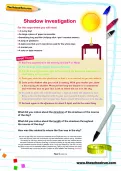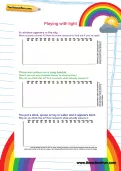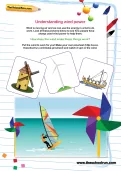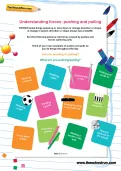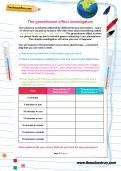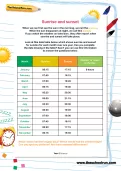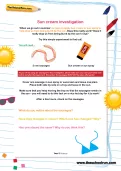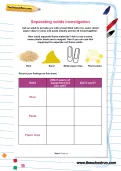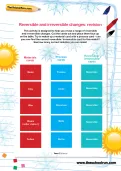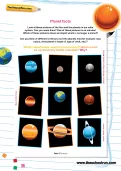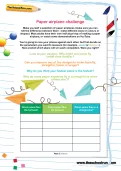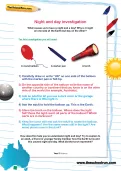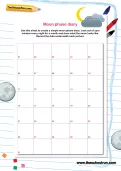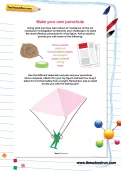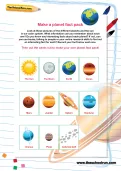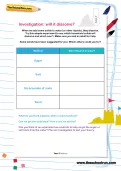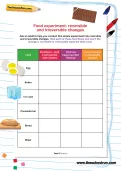Year 5 Physical processes worksheets
Understand the Earth's movements
An investigation and activity sheet to help Y5 children consolidate their knowledge about the Earth and how it moves in space.
Shadow investigation
A Year 5 science investigation into shadows and what they can tell us about the position of the Sun in the sky.
Learning about the moon
Find out about the Earth's moon and then answer some true-or-false questions in this Year 5 science worksheet.
Playing with light
What causes a rainbow to appear in the sky. Why are there colours in soap bubbles? If you put a stick, spoon or toy in water, why does it appears bent. Let's find out!
Understanding wind power
Wind is moving air and we can use the energy in wind to do work. Look at these pictures to see how people have always used wind power to help them. How does the wind make these things work? Put the wind to work for you! Make your own pinwheel and watch it spin in the wind.
Understanding forces: pushing and pulling
Pushing and pulling FORCES make things speed up or slow down or change direction or shape. A change in speed, direction or shape always has a CAUSE. Sort the following pictures into forces caused by pushes and forces called by pulls. Then think of your own examples of pushes and pulls as you do things throughout the day.
The greenhouse effect investigation
Our planet is constantly affected by different forces and factors – many of which are caused by humans. We often hear about something called “the greenhouse effect”… but what is it? The greenhouse effect is when our planet heats up due to harmful gases collecting in our atmosphere. This simple investigation will show you how it happens!
Sunrise and sunset
When we can first see the sun in the morning, we call this sunrise. When the sun disappears at night, we call this sunset. If you watch the weather on television, they often report when sunrise and sunset will take place. Look at this data table below which shows sunrise and sunset for London for each month over one year. Can you complete the data missing in the table? See if you can use this information to answer the questions below.
Sun cream investigation
When we go out in summer we have to apply sun cream or sun spray to help stop us from being burnt by the sun. Does this really work? Does it really stop us from being burnt by the sun’s rays? Try this simple experiment to find out!
Separating solids investigation
Ask an adult to provide you with a bowl filled with rice, sand, metal paper clips (or pins) and pasta (ideally penne) all mixed together. How could separate these materials? Ask to use a sieve, some plastic bowls and a magnet. See if you can use this equipment to separate out these solids.
Reversible and irreversible changes: revision
This activity is designed to help you revise a range of reversible and irreversible changes. Cut the cards out and place them face up on the table. Try to match up a material card with a process card – can you now find the correct reversible / irreversible card for this match? See how many correct matches you can make!
Planet facts
Look at these pictures of the Sun and the planets in our solar system. Can you name them? One of these pictures is an intruder! Which of these pictures shows an object which is no longer a planet? Can you think of different criteria to sort the planets into (for example: size, colour, what planet is made of, type of orbit, etc.)?
Paper airplane challenge
Make yourself a selection of paper airplanes. You’re going to race your planes against each other, but first decide on the parameters you want to measure (for example, speed or distance). Now predict which plane will win each completion. Were you right?
Night and day investigation
What causes us to have a night and a day? Why is it night on one side of the Earth but day on the other? Let's investigate!
Moon phase diary
Use this sheet to create a simple moon phase diary. Look out of your window every night for a month and draw what the moon looks like. Record the date underneath each picture.
Make your own parachute
Using what you have learned about air resistance, your challenge is to make the most effective parachute for a toy figure.
Make a planet fact pack
Look at these pictures of the different planets and the sun in our solar system. What information can you remember about each one? Do you know any interesting facts about each planet? If not, can you use books, talking to people or your online research skills to find out an interesting fact for each? Record your fact below each one.
Investigation: will it dissolve?
When we add some solids to water (or other liquids), they dissolve. Try this simple experiment to see which household solids will dissolve and which won’t.
Food experiment: reversible and irreversible changes
Ask an adult to help you conduct this simple experiment into reversible and irreversible changes. Heat each of these food items and see if the change is reversible or irreversible when the item cools.
Air resistance investigation
Air resistance is a force which slows moving objects down. When things move through the air, they are slowed down. Planes can move more quickly through the air by having a more streamlined shape – this means less surface area for the air to resist against. Do you fancy having a go at running your own simple investigation into air resistance?

